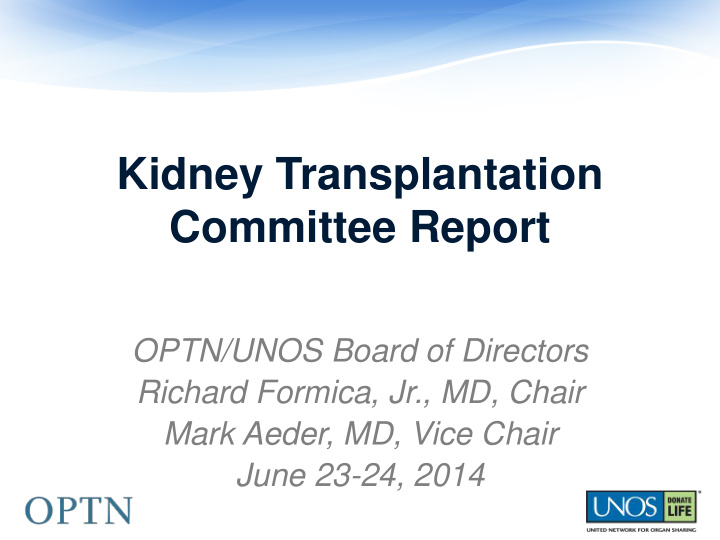



Kidney Transplantation Committee Report OPTN/UNOS Board of Directors Richard Formica, Jr., MD, Chair Mark Aeder, MD, Vice Chair June 23-24, 2014
Update on the Revised Kidney Allocation System (KAS)
KAS Resources KAS Toolkit Calculators Checklist Recorded Sample Patient Webinars Messaging Brochure
OPTN Website http://optn.transplant.hrsa.gov/news/newsDetail.asp?id=1634
Targeted Contacts Lab, OPO, and TXC Societies Other Organizations Members Administrators AST NKF Coordinators ASTS TRIO Physicians NATCO ARA Surgeons AOPO ESRD Networks Compliance staff STSW AKF Data Coordinators AMAT ADA Social Workers DTCP NRAA Program Directors ASHI AAKP Medical Directors ITNS ANNA Referring Physicians ASN PKD Foundation Laboratory staff
KAS Trainings Jan: Intro podcast/toolkit released Feb: Webinar on early referral Mar: Basics webinar/virtual town hall April: Processes and protocols webinar
KAS Trainings May: System training/programming release-new data entry June: System training/programming release-new reports September: e-Learning module for patient education October: Virtual town hall meeting
KAS Presentations OPTN TMF ASHI WTC NATCO ASN STSW Regions
Programming Releases EPTS Calculator March 19 • Fields for EPTS, KDPI, CPRA Approvals, A2/A2B May 27 • Reports: Candidate Points Report, CPRA Approvals Report, A2/A2B Eligibility Report June 19 •
As of June 17… 11,171 existing candidate records have had EPTS data verified 2,147 new registrations have had EPTS data verified
Implementation: Dec 2014 Notice of Final System Training Implementation Implementation Date
A Special Thank You… Kimberly Taylor, II Terri Bessom, Project Manager Angela Allen, II Kerrie Cobb, IT Joel Newman, Communications Team Ironfish, IT Anne Paschke, Communications Darren Stewart, Research Karen Sokohl, Communications Anna Kucheryavaya, Research Roger Brown, Organ Center Wida Cherikh, Research Chrystal Graybill, RA Gena Boyle, Policy Shannon Edwards, RA Kristina Tyler, Policy Betsy Gans, RA Elizabeth Miller, DEQ Cliff McClenney, RA Leslee Garland, DEQ
Simultaneous Liver-Kidney (SLK) Project
Problem Data suggests a portion of kidneys are allocated to liver candidates who likely would have regained their kidney function following a liver alone transplant Almost half of SLK recipients received a kidney with a KDPI less than 35% Current allocation scheme counter to Final Rule principles regarding best use of donated organs and policies being based on medical urgency
Multi-Committee Collaboration- SLK Workgroup Kidney Liver MAC Ethics
Committee Discussion Unknown whether KAS, PSR changes, MPSC outcomes project will have positive effect without allocation changes Possible Allocation Changes (builds off 2009 proposal) • SLK qualifying criteria • Safety net for liver alone recipients with kidney failure
Geographic Disparities in Deceased Donor Kidney Allocation
What Should Define Geographic Equity for Kidney Allocation? Duration on dialysis
Key Findings Huge variation in access to kidneys across DSAs • Case mix differences may explain some variation Median times to transplant often hard to estimate Excluding higher KDPI kidneys had little to no impact
Much larger impact… All or only recently listed patients? Active/inactive or only active patients? Which class of metric? (offer rates, transplant rates, supply v. demand)
Subcommittee Recs Include all donors in metric • No exclusion of DCD or high KDPI donors for supply v. demand, offer rates, and transplant rates Include only active patients in metric Consider a metric such as “% transplanted within 3 years” Group leaning toward ‘incident’ based metric
Points for Discussion Timing • Need to assess geographic disparity after KAS implementation • Evaluate lessons learned from Liver Committee throughout process • Periodic re-assessment/adjustment of metric Concerns • How to avoid metric that is influenced by behavior (i.e. center acceptance practices/OPO performance) • Whether to adjust for case mix • No correlation between offer rates and supply to demand
QUESTIONS?
Recommend
More recommend